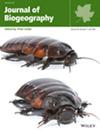Endemism Centres of the Five Richest Vascular Epiphyte Families in the Neotropics
Abstract
Aim
Endemic species, characterised by limited geographic ranges, face a high risk of extinction. The neotropical region harbours diverse ecosystems and a substantial number of endemic species, thus identifying areas of high endemism is crucial for protecting unique and threatened species and ecosystems. Vascular epiphytes—nonparasitic plants that grow on other plants without contact with the soil—exhibit remarkable diversity in the neotropics, with 63% of the global total of ca. 31,000 epiphyte species found in this region. This study aims to describe the endemism centres for the five most species-rich families of vascular epiphytes.
Location
Neotropics.
Taxon
Tracheophyta.
Methods
We gathered information from free-access web repositories, specific epiphytic plant databases and scientific and grey literature on epiphyte species of the families Araceae, Bromeliaceae, Orchidaceae, Piperaceae and Polypodiaceae within the neotropical realm as defined by Morrone et al. (2022). Geographical ranges were calculated using minimum convex polygons for 11,446 species, accounting for about 70% of all epiphyte species in the neotropics. Narrow endemic species were defined as those within the first quartile of the density distribution of geographic range sizes within each family and we identified endemism centres for epiphyte species of the five families.
Results
Our study identified endemism centres for vascular epiphyte species in several biogeographic provinces, including Paramo, Cauca, Guatuso-Talamanca, Atlantic, Yungas and Puntarenas-Chiriqui. Orchidaceae, accounting for most of the analysed species (71%), drove the overall distribution pattern; however, endemism patterns varied among families.
Main Conclusions
Regions with high epiphyte richness exhibited a greater proportion of endemic species, though the composition of epiphyte species varied considerably among regions. The endemism centres identified in this study could be prioritised as conserved and protected areas.


 求助内容:
求助内容: 应助结果提醒方式:
应助结果提醒方式:


